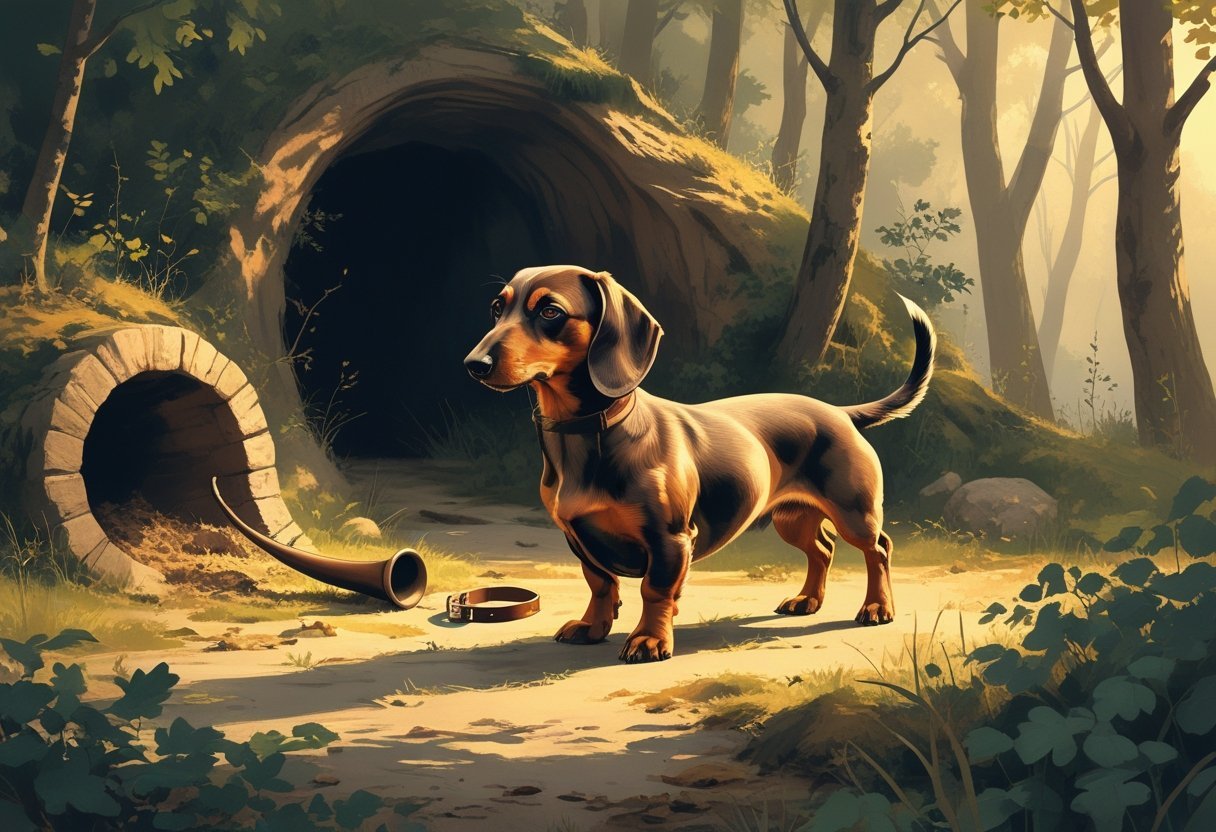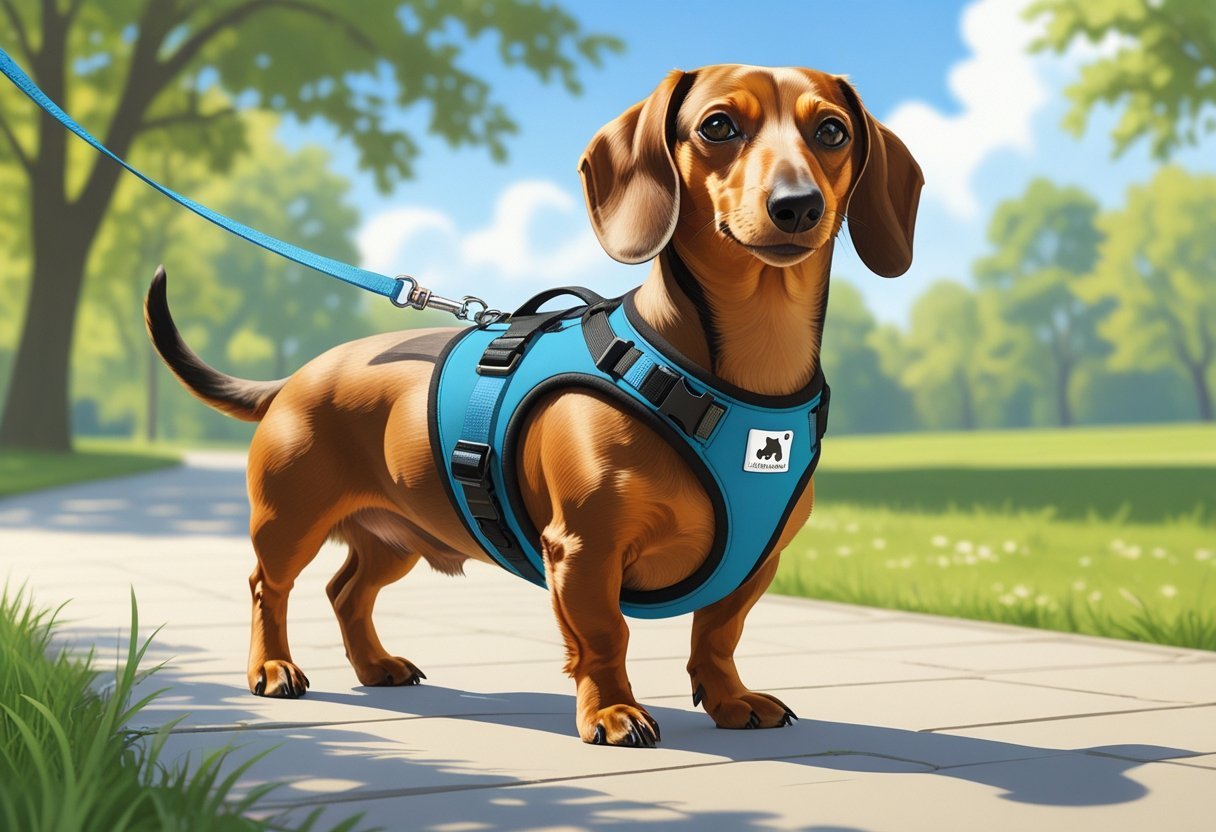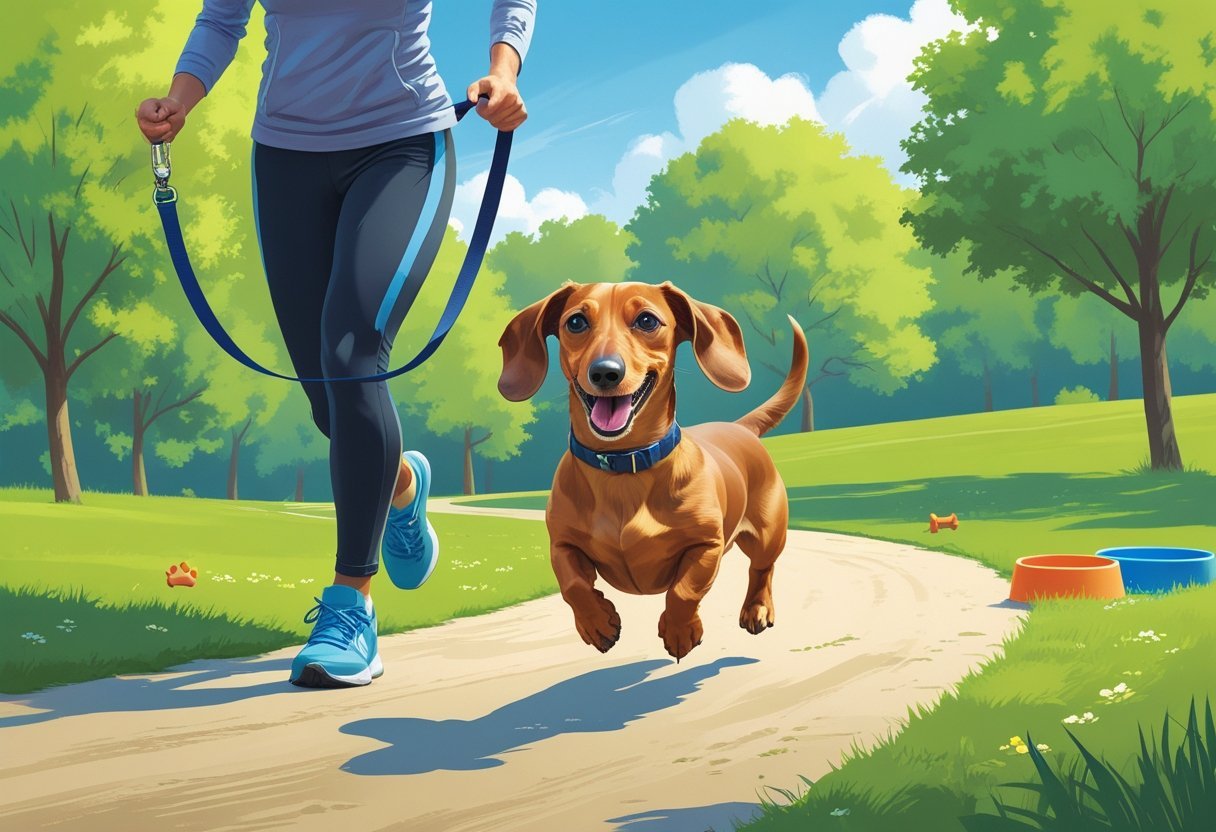Dachshunds, with those unmistakable long bodies and stubby legs 🐾, have a story that stretches back hundreds of years. The history of dachshunds dates back several centuries in Germany 🇩🇪, in the 16th century, bred for a single, gritty job.
Dachshunds were made for hunting badgers 🦡. Even their name literally means “badger dog” in German.
Their unique shape wasn’t just for show. That low, elongated body let them slip into badger dens, and those sturdy front paws? Perfect for digging ⛏️.
Despite their small size, they’ve always had a bold streak 💪—fearless enough to face off with badgers underground. That courage really set them apart ⭐.
Dachshunds have charmed everyone from royalty 👑 to regular folks. Over the years, they went from being working dogs to cherished companions all over the world 🌍, but they’ve never lost their signature look or that feisty personality ✨.
Key Takeaways 📝
- Dachshunds originated in 16th century Germany, bred for hunting badgers, and their shape was all about function. 🐕
- The name “Dachshund” literally means “badger dog,” which says a lot about their original job and attitude. 🦡
- They shifted from hunters to companions but kept their unique looks and spirited nature. ❤️
🐾 Free Dachshund Care Guide
Download our free checklist to ensure your Dachshund stays happy, healthy, and well-loved!
Get Your Free Guide 🐶Origins of the Dachshund
The Dachshund’s roots run deep in Germany 🇩🇪, stretching back centuries. People there shaped these dogs for hunting 🎯, and their oddball silhouette made them perfect for the job.
Early German Roots 🌿
Dachshunds showed up in Germany as early as the 15th century 📜. Their name comes straight from German: “dachs” for badger, “hund” for dog 🦡.
Paintings and records from the 16th century already show dogs that look a lot like the ones we know today 🎨. Bavaria played a big role in their development, with everyone from nobles to farmers getting on board 👑👨🌾.
German hunters needed a gutsy dog that could chase prey underground. The earliest Dachshunds were bigger than today’s, tipping the scales at 30–35 pounds ⚖️ and sporting longer legs.
By the 17th century, they were everywhere in the German states 🏰. Hunters loved their bravery and sharp noses 👃.

🥗 Wild Earth Complete Protein Vegan Dog Food – Clean Energy for Brave Little Hunters
Inspired by their fearless past, today’s Dachshunds thrive on nutrition that’s gentle, balanced, and plant-powered 🌿. A perfect fit for dogs with sensitive tummies but bold spirits.
- Complete & balanced protein for small but mighty bodies 💪
- Supports digestion and steady energy for daily play 🐾
- Crafted with clean, sustainable ingredients 🌎
Development as a Badger Dog 🦡
People bred Dachshunds with one thing in mind: badger hunting. That’s why they have such an odd shape—long, skinny bodies for squeezing into burrows, and muscular chests and legs for digging ⛏️.
Even their curved tails had a purpose. Hunters could grab them and pull the dog out of a tunnel if things got dicey 🚪.
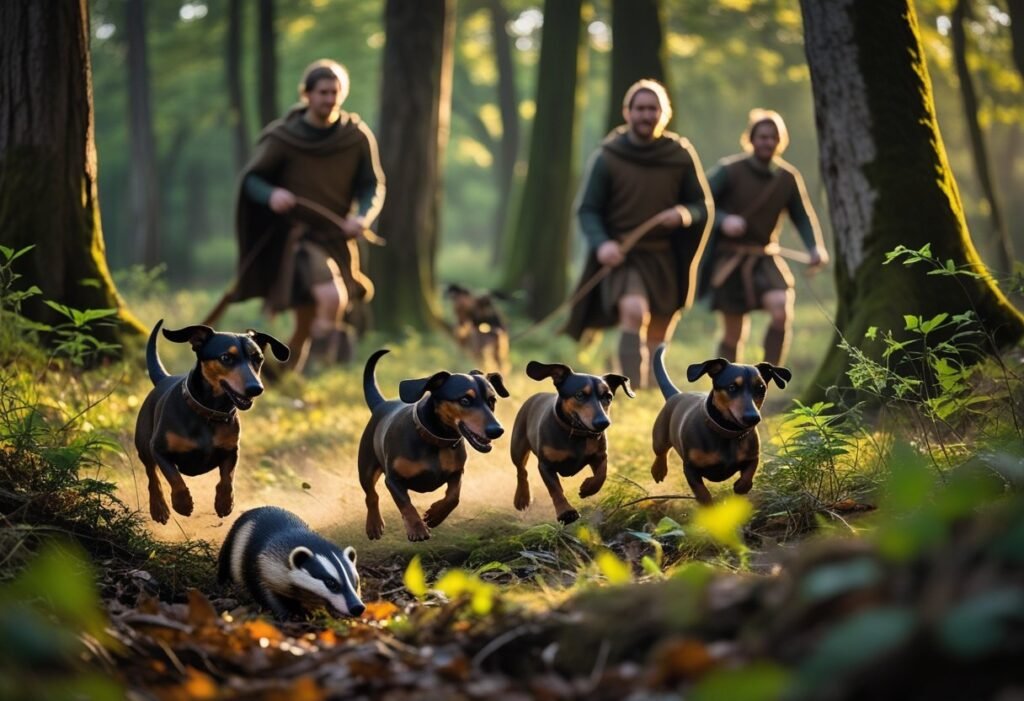
Breeders picked traits that made them better hunters:
- Short legs: Fit for tight tunnels 🕳️
- Keen nose: To sniff out prey 👃
- Loud, deep bark: So hunters could hear them underground 🔊
- Tenacity: No backing down from a fight 💪
They didn’t stop at just one kind. Smooth-coated Dachshunds took on badgers, longhaired ones went after forest game 🌲, and wirehaired Dachshunds battled through thorny brush 🌿.
Breeding Timeline ⏳
Formal breeding started in the 18th century, but things got official in the 19th. The first Dachshund club popped up in Germany in 1870 📅, and they set the breed standard in 1879.
Some milestones:
- 1840s: Breeders crossed smooth Dachshunds with Spaniels to get the longhaired type 🐕
- 1890s: Wirehaired Dachshunds came from mixing in terriers and wirehaired pinschers 🐾
- 1885: The American Kennel Club registered its first Dachshunds 🇺🇸
By the late 1800s, they’d made three coat types and two sizes. Miniature Dachshunds were perfect for chasing rabbits 🐇. German breeders kept strict standards and didn’t keep dogs that couldn’t hunt.
Queen Victoria really loved Dachshunds in the 1800s 👑, and her affection helped them become popular across Europe 🌍.
Purpose and Function in History
Back in medieval Europe, people shaped Dachshunds for a single job: hunting 🎯. Their body and personality were all about that task 🐾.
Why Were Dachshunds Bred ❓
Dachshunds were bred for badger hunting—no surprise if you know their name 🦡. Their long, low bodies let them slip into burrows, and their powerful paws made digging a breeze ⛏️.
That broad chest? It gave them the lung power they needed for long stints underground 💨. Their stubborn streak wasn’t just a quirk—it helped them keep going when things got tough 💪.
Breeders picked dogs that showed courage and determination ⭐. Standard Dachshunds (16–32 pounds) hunted badgers and even wild boar 🐗. Miniatures (under 11 pounds) chased rabbits and smaller prey 🐇.

🥩 ChefPaw Fresh Food Maker
- Fresh, healthy meals tailored for your Doxie 🍲
- Control ingredients to support long-term health
- Easy prep for busy families

🛁 Pride + Groom Grooming Tools Kit
- Gentle tools designed for sensitive Doxie coats ✨
- Helps maintain shine and reduce shedding
- Turn grooming into bonding time ❤️
The Badger Hunting Tradition 🦡
In medieval Germany, badger hunting mattered. Badgers ruined crops and competed with people for food 🌾, so farmers and landowners relied on Dachshunds to protect their land 🏡.
During hunts, Dachshunds would sniff out dens and either flush out badgers or take them on underground 🔦. Their bark let hunters know where they were, even when out of sight 🔊.
Hunting with Dachshunds was a team effort. Hunters often used several dogs together to take on these tough animals 🤝.
By the 1600s, German hunters had refined the breed for this job 🏹. The tradition lasted for centuries ⏳, and only later did Dachshunds become the companions we know today ❤️.
Evolution of the Breed Standard

🎉 Grab your free Dachshund care checklist!
The Dachshund standard has changed a lot since their hunting days 🔄. Over time, people created detailed guidelines to define the perfect Dachshund 🐾.
Emergence of Breed Varieties 🌿
Germany set the first official breed standard in the 1870s 📜. At first, only smooth-coated Dachshunds made the cut, standing about 30–35 cm tall and weighing around 15–16 kg ⚖️.
By the 1890s, breed clubs started recognizing three coat types: smooth, longhaired, and wirehaired 🐕. Each one suited a different hunting job or terrain 🌲.
Size categories changed too. The FCI eventually recognized standard and miniature sizes, and the American Kennel Club added a third: the “rabbit” Dachshund 🐇, for hunting even smaller animals.
Colors and patterns multiplied 🎨. Beyond the classic red and black-and-tan, you can now find chocolate, cream, blue, and all sorts of dappled coats 🌈.

🩺 The Swiftest – IVDD Insurance Comparison Tool
- Compare pet insurance plans built for Dachshunds
- Find coverage that protects against IVDD risks 🐾
- Peace of mind for your family and your pup

🎨 Purr & Mutt Personalized Dachshund Wall Art
- Turn your Dachshund’s silhouette into custom art 🖼️
- Add charm and history to your home décor
- A perfect gift for Doxie lovers everywhere 🎁
Role of Selective Breeding 🧬
Selective breeding turned Dachshunds from no-nonsense hunters into companion dogs with a signature look ❤️. Early breeders cared more about how they worked than how they looked 👀.
Eventually, people started focusing on their appearance too. Breeders picked for that long body, short legs, and sharp hunting instincts that still define the breed ⭐.
In the early 20th century, the breed’s proportions became more refined 📏. The famous 2:1 length-to-height ratio became the goal 🎯.
Health started to matter more in modern breeding 🩺. Breeders now try to reduce hereditary issues like back problems, though they still want to keep the Dachshund’s unique silhouette 🐶.
Cultural Significance Through the Ages
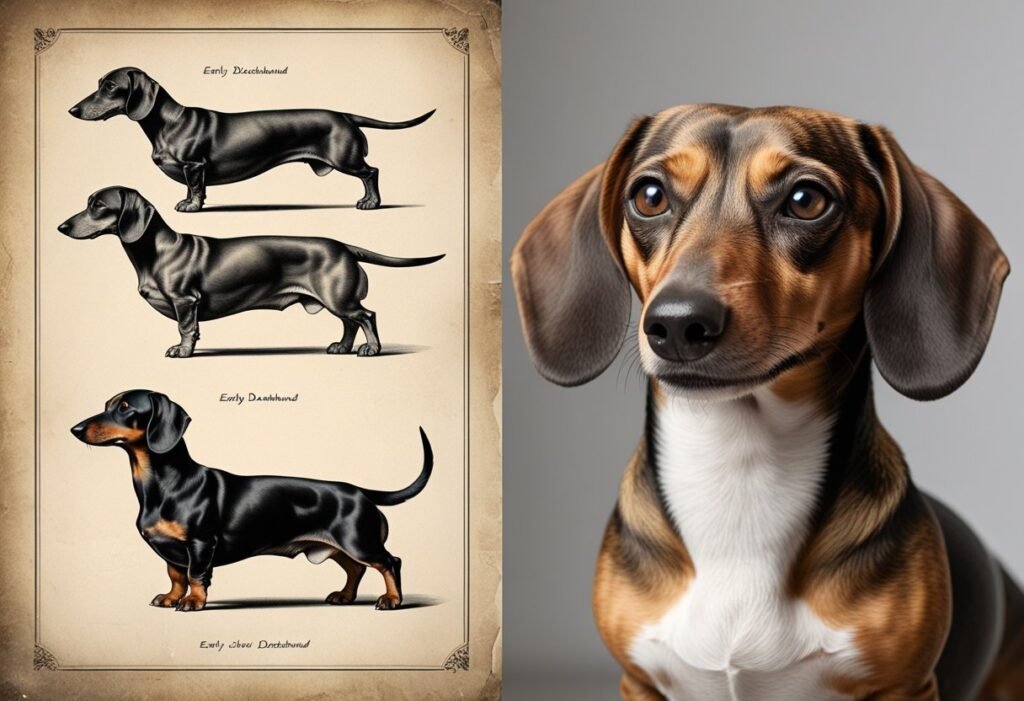
Dachshunds have become more than just dogs; they’re part of the culture in many places 🌍. Their look and personality have made them favorites in stories, art, and even pop culture 🎨📚.
Dachshunds in German Folklore 🇩🇪
In Germany, Dachshunds are more than hunters—they’re symbols. The breed’s name itself is a nod to their roots, but by the 19th century, they’d become a national icon 🏰.
They pop up in German folk tales as clever, plucky heroes 📖. That bravery made them natural stars in stories where the little guy outsmarts the big one ⭐.
During festivals, Dachshund-themed decorations and toys were everywhere 🎉. Even now, “Teckel Clubs” (another German name for the breed) throw events and parades to celebrate their history 🎈.
🌟 Smart Living & Comfort Picks for Your Dachshund’s Journey
- 🧠 Brain Training for Dogs — Stimulate your Doxie’s mind with fun, science-based games that prevent boredom and boost confidence.
- 🍖 Petlibro Auto Feeder — Schedule precise, consistent meals to keep your pup’s tummy happy (even when you’re busy).
- 🛏️ Majestic Pet Orthopedic Bed — Give your Dachshund’s long back the extra joint support and comfort they deserve.
- 📍 Tractive Dog GPS Tracker — Track your adventurous pup in real-time and enjoy peace of mind on every outing.
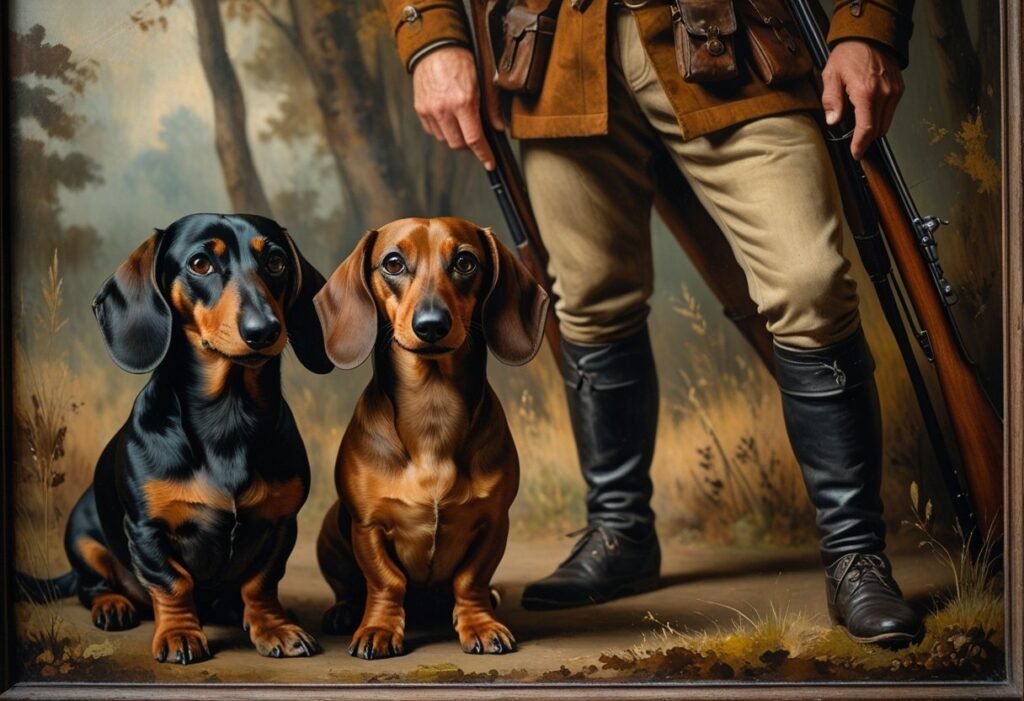
Presence in Art and Literature 🖌️
Artists and writers have loved Dachshunds for centuries. Their silhouette shows up in old paintings—sometimes with hunters, sometimes just as family pets 🐾.
Pablo Picasso had a Dachshund named Lump 🖼️, who inspired some of his work. Andy Warhol painted them too, in his signature style 🎨.
Dachshunds appear in books by E.B. White and John Steinbeck 📚. Their loyalty and spunky nature make them great characters, whether it’s in a kid’s story or a classic novel ✨.
Even Queen Victoria and William Randolph Hearst had Dachshunds 👑📰. Their dogs showed up in portraits, newspapers, and just about everywhere else 🐕.
Dachshunds’ Spread Beyond Germany
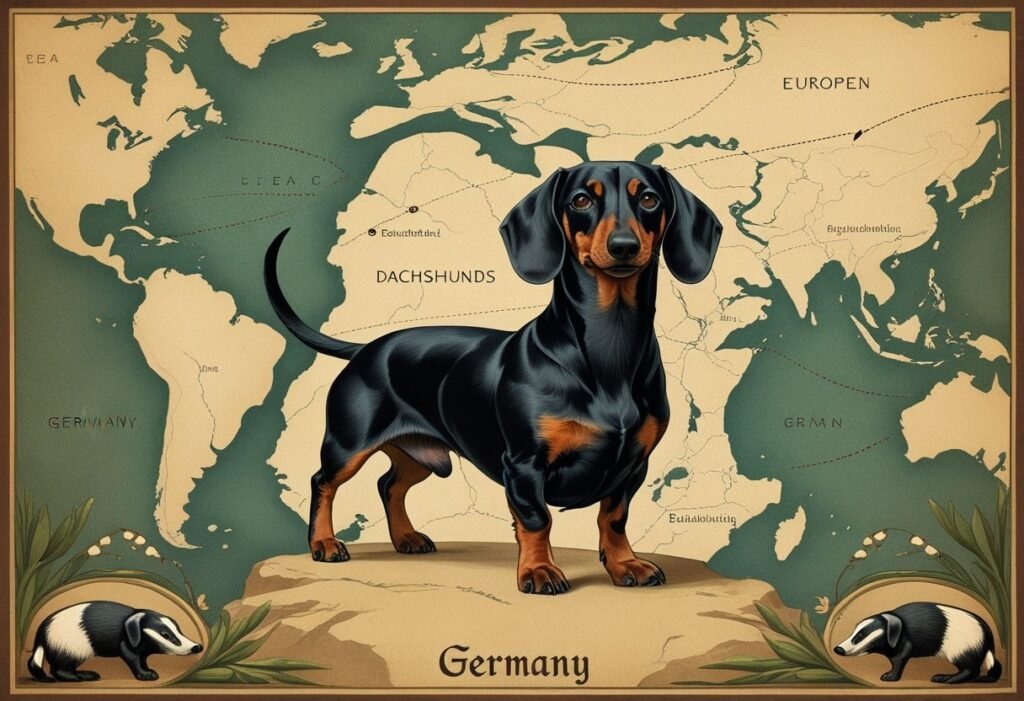
In the 1800s, Dachshunds started their journey abroad 🌍. They gradually won over people across Europe and eventually made their way to America 🇺🇸.
As folks realized how loyal and entertaining these dogs could be 💕, Dachshunds shifted from badger hunters to beloved family pets 🐾. And honestly, who could blame them? 😍
Introduction to Other Countries ✈️
Dachshunds started showing up outside Germany in the late 19th century 📜. Queen Victoria of England adored them 👑, which definitely helped boost their popularity in Britain 🇬🇧.
Her royal stamp of approval made dachshunds the trendy choice among English high society 🎩. By the 1880s, dachshunds had made their way to the United States 🇺🇸.
The American Kennel Club recognized the breed in 1885 📅. Their popularity in the US grew until World War I, when anti-German feelings led to a dip in their numbers ⚔️.
In Russia, dachshunds caught the attention of the aristocracy 🏰. They also found fans in France 🇫🇷 and Scandinavia ❄️, where people appreciated their hunting skills in all sorts of landscapes 🌲.
💛 Trusted Picks to Keep Your Dachshund Happy & Healthy
- 🧬 AnimalBiome Dog Gut Health Test Kit – Discover what’s happening inside your Doxie’s tummy for better health choices.
- 🌿 Zumalka Anxiety Relief Drops – Gentle, natural support to ease stress during vet visits or travel.
- 📹 Petcube Cam 360 – Stay connected and check in on your pup’s daily adventures from anywhere.
- 🫧 King Klean Dog Shampoo – Give your Dachshund’s coat the royal treatment with this soothing, natural shampoo for shiny, healthy fur.
- 👕 Dog is Good Shirt – Wear your Doxie love proudly with comfy, stylish apparel made for dog lovers.
🐾 Small touches like these make a big difference in your Dachshund’s life and yours.

Adaptation as a Companion Animal 🐕❤️
Dachshunds started out as hunting dogs, but they adapted surprisingly well to family life 🏡. As hunting with dogs faded in the early 20th century, people began keeping them as companions instead 🤗.
Breeders focused more on temperament, picking dogs that would fit in better at home 🛋️. This selective breeding made them friendlier and toned down some of their more intense instincts 🌟.
Their small size worked perfectly for apartment dwellers 🏢. Unlike other hunting breeds, dachshunds didn’t need endless space to run, which made them a good fit for city life 🚶.
Let’s be honest, their oddball bodies and expressive faces are a huge part of their appeal 😄. People who wanted a dog with personality often ended up picking a dachshund 💫.
Modern Interpretation of the Dachshund’s Heritage

Today, our understanding of Dachshunds blends historical research with modern genetics 🧬. It’s pretty wild how much we’ve learned about this breed’s roots and true purpose 📖.
Contemporary Roles and Recognition 🌟
Dachshunds have gone from specialized hunters to all-around companions 🐾. Sure, you probably know them as family pets 🏡, but many still compete in field trials and earthdog events that show off their hunting chops 🎯.
The American Kennel Club recognized the breed in 1885 📅 and now ranks Dachshunds among America’s top 15 most popular dogs 🇺🇸. Their numbers dipped during the World Wars because of their German background ⚔️.
Genetic studies back up what historians have guessed for ages 🔬—Dachshunds share DNA with scent hounds like Bloodhounds 🐕. That’s probably why they’re so stubborn and have such a sharp nose 👃.
There are three coat types—smooth, wirehaired, and longhaired—and two sizes: standard and miniature ✂️. No matter the type, they keep that iconic long body and short legs that made them perfect for badger hunting 🦡.
🐾 Don’t Miss Out!
Download our free Dachshund care guide to keep your furry friend happy and healthy.
Get Your Free Guide 🐶Frequently Asked Questions

Curious about Dachshunds’ fascinating past? 🐾 This FAQ section covers the most common questions about their origins, hunting roles, and evolution through history.
From their early days as fearless badger hunters to becoming beloved companions worldwide 🌍, these answers will give you quick insights into how the breed developed and why they’re still so special today.
What is the historical origin of the Dachshund breed? 📜
Dachshunds originated in Germany in the 15th century 🇩🇪. The first written mention of them dates back to 1515, but honestly, similar dogs probably existed even earlier ⏳.
German hunters and foresters bred these dogs for hunting 🎯. Their name comes from the German words “dachs” (badger) and “hund” (dog) 🦡.
Germany officially recognized the breed in the early 1800s 📅. Dachshunds quickly gained fans across Europe after that 🌍.
How has the appearance of the Dachshund evolved from its original form? 🐕
Early Dachshunds were bigger and heavier than today’s dogs—think 30 to 40 pounds ⚖️. That stocky build helped them take on badgers underground 🦡.
Selective breeding shortened their legs over time 🦴. Modern show Dachshunds look a bit more exaggerated than their working ancestors 👀.
Originally, only smooth coats existed, but by the late 1800s, breeders had introduced longhaired and wirehaired versions too ✂️.
For what purpose were Dachshunds originally bred? 🎯
Dachshunds were made for hunting badgers 🦡. Their long, low bodies let them squeeze into badger dens without much trouble 🕳️.
They’ve got strong, paddle-shaped paws for digging ⛏️. Their deep chests give them enough lung power to work underground for a long time 💨.
People also used them to hunt foxes and rabbits 🦊🐇. Some of the larger ones even joined wild boar hunts 🐗, which sounds a bit wild.
Did Dachshunds play a significant role in badger hunting? 🦡
Dachshunds were a big deal for badger hunting in central Europe 🏞️. Their bravery in the face of angry badgers made them favorites among hunters 💪.
Hunters often used packs of Dachshunds 🤝. The dogs would find, corner, and sometimes even fight badgers until people could dig them out ⛏️.
Their grit earned them a reputation as fearless hunters ⭐. Old records show people relied on them to control badger populations that messed with crops and livestock 🌾.
What were the original sizes and variations of the Dachshund breed? 📏
There were two main sizes: standard Dachshunds for badgers and smaller ones for rabbits and foxes 🐾. Miniatures got especially popular in the 1800s 🎩.
Coat types developed to suit different terrains 🌲. Smooth coats came first, wirehaired for thorny areas 🌿, and longhaired for cold places ❄️.
Even back then, colors and markings varied a lot 🎨. You’d see solids, dapples, brindles, and all sorts of patterns in early Dachshunds 🌈.
How did the term ‘badger dog’ come to be associated with Dachshunds? ❓
In German, “Dachshund” literally means “badger dog” 🦡. That name points straight at their original job—hunting badgers 🎯.
As the breed caught on across Europe 🌍, people started using the term everywhere. You can spot their badger-hunting roots just by looking at them 👀.
Short legs, a long spine, and a sturdy build—they’re clearly made for squeezing into tunnels after prey 🕳️. It’s wild how perfectly their bodies fit that purpose 🔥.
Even when people started keeping them for other reasons, the name never really faded ⏳. By the 1800s, folks in different countries often used “Dachshund” and “badger dog” like they meant the same thing 💬.
How did Dachshunds become symbols of loyalty and charm worldwide? 🌍
Dachshunds gained their reputation not only from hunting but also from their devotion to people 🐾. As they spread beyond Germany, families discovered their affectionate nature, quirky personalities, and courage far bigger than their small bodies.
Their playful spirit and loyalty made them favorites in royal courts, homes, and even modern pop culture ✨. Over time, Dachshunds came to symbolize resilience and charm.
Today, they’re celebrated not just as hunting dogs of the past, but as companions whose personalities brighten homes around the globe ❤️.

